In Part 1, I went through data moats, which I mostly don’t believe in. Here are my conclusions for “data as a moat”:
- Most competitive differences ascribed to data are just early-stage effects.
- Data-enabled learning and activities can be temporary operating advantages for early movers. But this is usually a short-term effect.
- Data can be a barrier to entry.
- Cars need lots of miles to learn to drive and this case is difficult to replicate.
- But this type of data barrier is usually not too hard to overcome.
- Data is almost never a network effect or scale advantage.
- Data network effects are mostly just theory. Maybe Google Search and Waymo.
- There is a real trade-off between data quantity and quality. So, data scale advantages are not obvious moats.
- Data CAN be a scarce resource competitive advantage.
- It can be proprietary data as a corpus. Or as a system for acquiring proprietary data on an ongoing basis.
- Data-enabled learning and adaptation might become a sustainable operating advantage.
- This is the key question I am thinking about. It’s on my SMILE marathon list.
I think the key question for most management teams is:
- How can you improve your operating performance with data-enabled activities? Especially learning, adaptation and intelligence?
That last question is the point of this article. And this is basically my playbook for data-empowered operations.
Play 1: Sell Data as a Product. Or as Part of a Digital Service.
Selling data is a pretty good business. It’s profitable and it gets your customers to pay for your ongoing data capabilities. That’s great as data activities are usually an operating expense. It makes it hard to reinvest aggressively when it’s always a cost.
–
I’ve mentioned how consulting firms sell data as a product. Firms like Gartner monetize their research. Firms like McKinsey have indexes and best practices.
A more common approach is to add digital services to existing products or services. Once a product becomes smart (regular toy to digital toy, regular refrigerator to smart refrigerator), it becomes a source of data and a platform for new services. Smart tractors gather data and you can sell the owners predictive maintenance services.
I talked about these sorts of plays in consumption ecosystems.
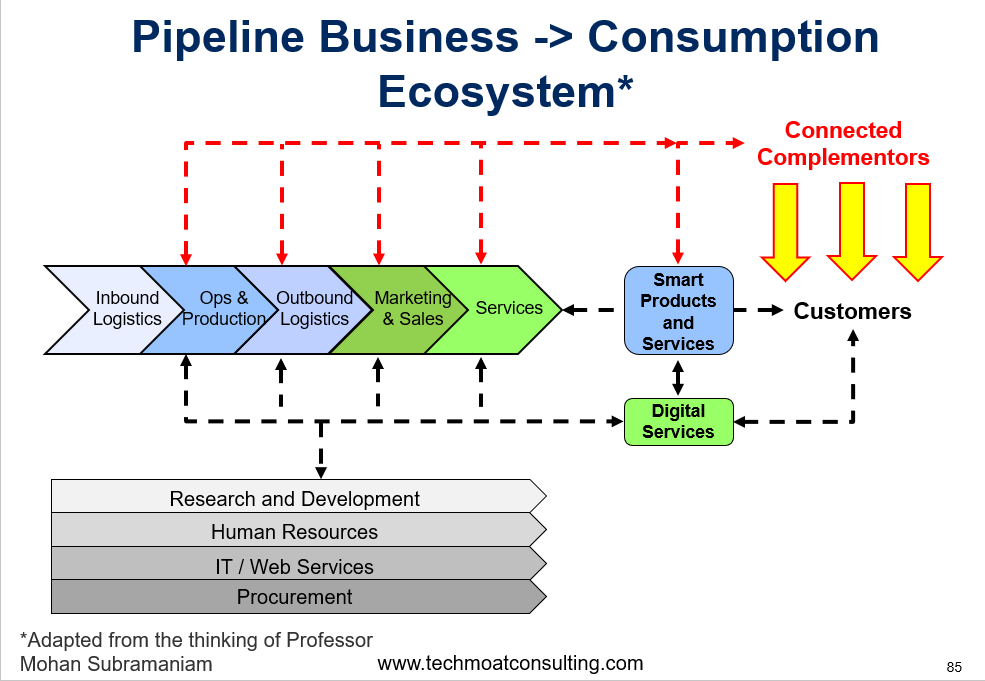
But you need to be honest about how important these digital services are. Smart brakes are very important customers. A smart blender sounds good but is not that useful to consumers.
Play 2: Be Aggressive in Analytics Use Cases. Expand to Insights and Predictions.
Digital Operating Basics 3 is about building a digital (and now AI) core. This centralizes all the information to one location. And it lets you runs all sorts of historical analysis. With AI it lets you make predictions.
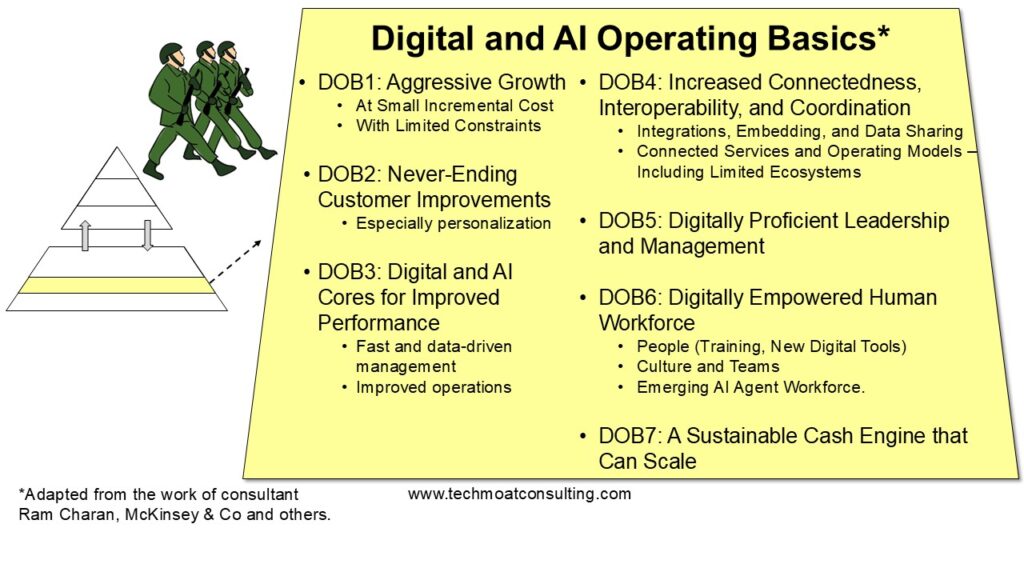
You also hear a lot about “customer insights”. How having such data lets you see into customer behavior and preferences. And therefore, you can create better services.
And this is true. Sort of.
Data-enabled customer improvements is like 50% of my overall digital strategy. You want a feedback loop between customer usage and increasing customer value. The other 50% is moats.
But this is a lot more than just insights. You need a customer improvement / personalization engine.
Customer “insights” are usually pretty simple. And most are easy to copy. For example, if Amazon is recommending you two paired books, that type of customer insight is pretty easy to copy. So, I think insights gets too much attention.
The powerful part is when you go from insights to a personalization engine, with lots of touch points. And you have a system for real-time intervention based on customer data. You want the right promotion (or action) for the right customer at the right moment in the right channel. You really need to go from “insights” to a personalization engine. Here’s how that looks:
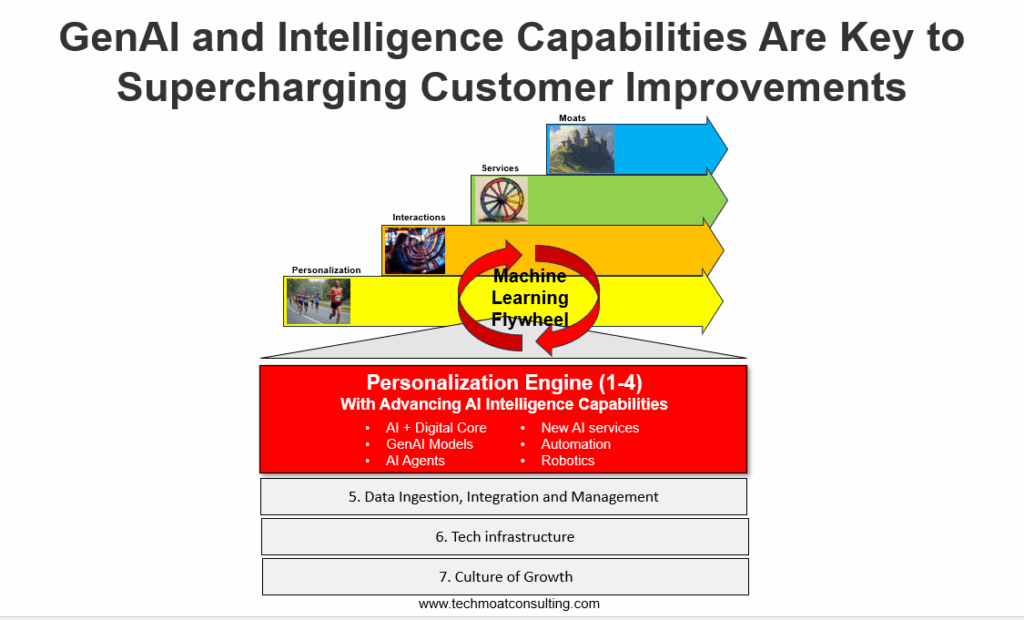
That said, you want to be aggressive in historical analytics.
Two other points to think about:
- This is becoming more about prediction. AI and now GenAI are proving a good substitute for humans in predictions. And this means data (the complement) is increasing in value.
- You also want both internal and external data, analysis, insights and prediction. And this can be from partners or from a data ecosystem. I put that in DOB4.

Play 3: You Want Fast and Data-Driven Decision-Making by Management. And You Need to Track the Speed.
The first thing I do when the digital core is put in place (DOB3) is create management dashboards. These make managers much smarter and faster.
Jeff Bezos talked a lot about reducing friction in decision making. He said there were two types of decisions. Those that are reversible like experimenting with new features and pricing tweaks. And non-reversible ones, like investments and executive hiring. You want to move really fast in the first type. That’s what management dashboards are good for.
However…
I talk a lot about getting faster. You can see it everywhere in my slides. Operating performance always needs to get smarter, faster and better.
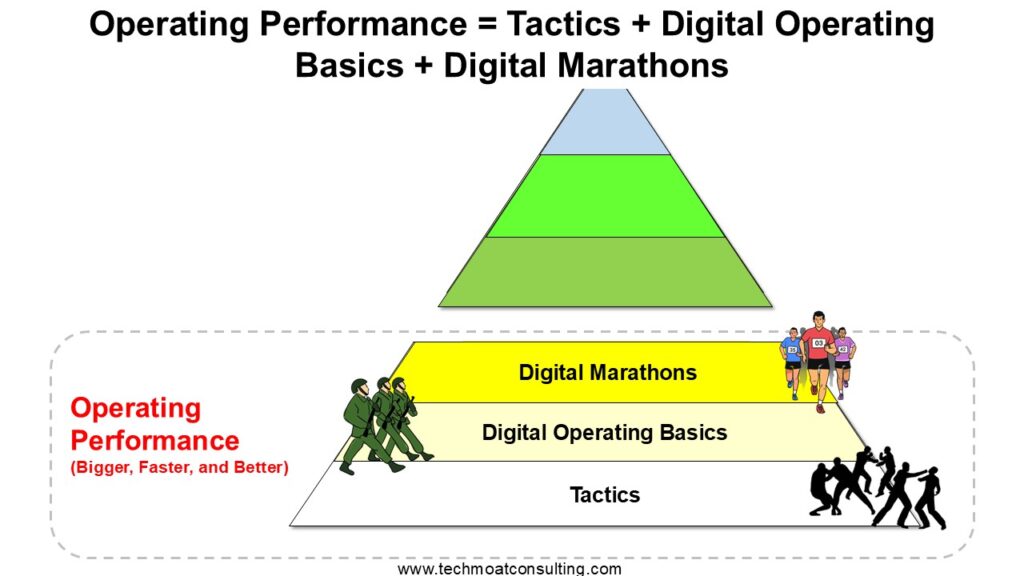
But getting faster is a process. You speed up incrementally over time. So, you need to track the speed of management decisions. You need to measure it. You can do this by the number and frequency of meetings for decisions.
Another point to think about is the culture of management. Being data-driven is often new to many managers. They need to get used to the idea that everything is a hypothesis until it is proven with data.
Play 4: Use Data Products to Empower Agile Teams
Consultants write a lot about agile teams (often called pods). McKinsey & Co has entire books on this. Over time, this team-based organization structure has been expanding from software companies to more traditional businesses. Ideally, you want 50-100 agile teams constantly working on new features, pain points, and new products in your business. You combine this type of bottom-up innovation and execution with top-down strategy and guidance.
But discussions about agile teams usually become discussions about talent and data products. Getting the right people is difficult. So is getting them used to working on empowered teams.
Data products are the other requirement. They are the key tools for agile teams. You want standardized data products that can be used across lots of teams over time. A data product that gives easy and comprehensive access to customer information and behavior is super useful for these teams.
So, you want to lean into creating standardized data products that can empower agile teams. And within this, I mostly focus on teams doing:
- Customer improvements.
- Operational efficiency. Productivity improvements are great. Ideally, you want digital initiatives that both increase revenue and save money. BCG talks a lot about this.
Play 5: Build a System for Rate of Learning and Adaptation. This is a Powerful Use of Data.
Data is only valuable when you use it. So, you want a system for constantly processing data and feeding it into organizational learning and action. You want a rate rapid of learning and adaptation. This can be at the individual level, the team level, and the organization level.
For customer improvements, this is when you go from DOB2 to a customer improvement / personalization engine. That is what 1a is in this graphic.
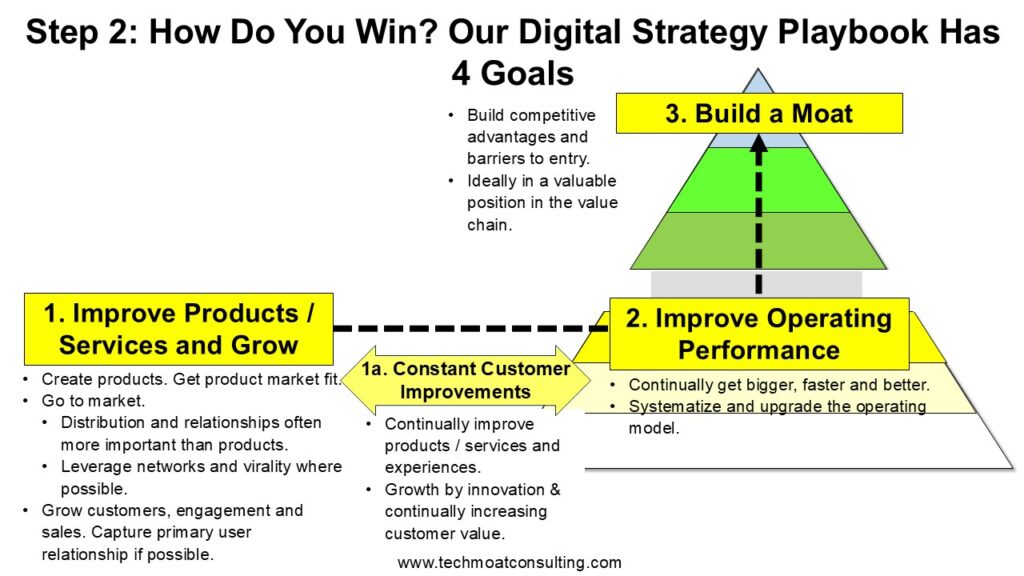
And here is my playbook for this.

But you can build such learning and adaption systems into other parts of the enterprise. Into factory operations. Into call center operations. Into R&D.
And sometimes, this becomes a sustainable operating advantage. I put this in my SMILE marathon list.

But it all depends on data gathering and feedback.
Play 6: Begin Building Operating Systems for Intelligence and Knowledge
This is the big new thing. And it’s mostly theory at this point.
- Can you build intelligence into your business?
So, it’s not just feeding data and insights to humans. It’s about the business having its own native intelligence.
That means vector databases and knowledge graphs. These internal intelligence systems can be specific to an industry or a single business. Knowledge graphs are good at providing specific facts and precise information (“What is the capital of France?”). Vector databases are good at fuzzier relational information (“Give me articles about Paris?”). Both feed into LLMs to improve performance.
This is pretty much the Baidu AI Cloud strategy. They are pushing for lots of usage of the GenAI foundation models on the industry side (say manufacturing) and they are creating a feedback loop where this makes their industry-specialized models more intelligent. They have a flywheel between model usage and knowledge graphs and vector databases. Plus there is feedback into structured databases, and model weights.
Here is how Baidu describes it:
“The core advantages of ERNIE lie in its knowledge enhancement and industrial-level application.”
“The (ERNIE) model learns from large-scale knowledge maps and massive unstructured data, resulting in more efficient learning with strong interpretability.”
“It also aims to promote the intelligent upgrading of industries by constructing a foundation model system that is more suitable for specific scenario requirements. This includes providing tools and methods to support the entire process and creating an open ecosystem to stimulate innovation.”
Here is my article on that.
On the more theoretical side, Sanjeet Choudary predicted (in his book Reshuffle) that GenAI will create an organization brain in businesses. The internal knowledge of a business (mostly in files and people’s heads) will be captured by internal knowledge systems. And one of the places this will have impact will be in feeding such knowledge to agile teams. That would be a big upgrade to the current data products just mentioned. More on that here.
And finally, there is the idea of intelligent AI agents. Tencent Cloud and Huawei are both doing a big push into intelligent agents right now. And into multi-agent systems.
I’m not sure where this is going. But I’ve teed this up in my frameworks as “Rate of Learning and Adaptation. Plus, Intelligence.”
***
Ok. That’s pretty much playbook. Here is a summary:
My Playbook for Data-Empowered Operations
- Sell Data as a Product. Or as Part of a Digital Service.
- Be Aggressive in Analytics Use Cases. Expand to Insights and Predictions.
- You Want Fast and Data-Driven Decision Making by Management. And You Track the Speed.
- Use Data Products to Empower Agile Teams.
- Build a System for Rate of Learning and Adaptation. That is a More Powerful Version of All of This.
- Begin Building Operating Systems for Intelligence and Knowledge.
Cheers, jeff
- Data Network Effects and Data Scale Aren’t Moats (1 of 2) (Tech Strategy)
- My Playbook for Data-Empowered Operations (Tech Strategy – Podcast 261)
——
Related articles:
- How Alibaba.com Re-Ignited Growth with the Alibaba Management Playbook (Tech Strategy – Podcast 253)
- How Amap Beat Baidu Maps. My Summary of the Alibaba Playbook. (Tech Strategy – Podcast 252)
- Scale Advantages Are Key. But Competitive Advantages Are More Specific and Measurable. (Tech Strategy)
From the Concept Library, concepts for this article are:
- Smile: Rate of Learning and Adaptation
- Digital Operating Basics 3: Digital Core
- Data-Empowered Operations Playbook
From the Company Library, companies for this article are:
- n/a
——-
I am a consultant and keynote speaker on how to accelerate growth with improving customer experiences (CX) and digital moats.
I am a partner at TechMoat Consulting, a consulting firm specialized in how to increase growth with improved customer experiences (CX), personalization and other types of customer value. Get in touch here.
I am also author of the Moats and Marathons book series, a framework for building and measuring competitive advantages in digital businesses.
This content (articles, podcasts, website info) is not investment, legal or tax advice. The information and opinions from me and any guests may be incorrect. The numbers and information may be wrong. The views expressed may no longer be relevant or accurate. This is not investment advice. Investing is risky. Do your own research.
